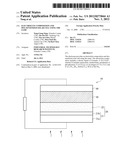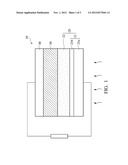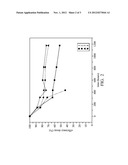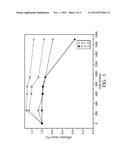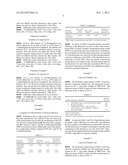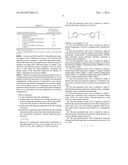Patent application title: ELECTROLYTE COMPOSITION AND DYE-SENSITIZED SOLAR CELL USING THE SAME
Inventors:
Yung-Liang Tung (Hsinchu County, TW)
Jia-Yin Wu (Taichung City, TW)
Jen-An Chen (Miaoli County, TW)
Wen-Yueh Ho (Tainan City, TW)
Yu Kai Chou (Taipei, TW)
Assignees:
INDUSTRIAL TECHNOLOGY RESEARCH INSTITUTE
IPC8 Class: AH01L310256FI
USPC Class:
136263
Class name: Photoelectric cells organic active material containing
Publication date: 2012-11-01
Patent application number: 20120273044
Abstract:
The disclosure provides an electrolyte composition and dye-sensitized
solar cell using the same. The electrolyte composition includes a diionic
liquid of Formula: Z.sup.-(X-Y-X)Z'.sup.-, wherein X includes ammonium,
imidazolium, pyridinium or phosphonium, Y is (CH2)n, n is an integer
of 1-16, Z is I, and Z' is I, PF6, BF4, N(SO2CF3),
NCS or N(CN)2.Claims:
1. A dye-sensitized solar cell, comprising: a working electrode, wherein
the working electrode comprises an electrode substrate and an oxide
semiconductor porous film formed on the electrode substrate; a counter
electrode disposed oppositely from the working electrode; an electrolyte
composition provided between the working electrode and the counter
electrode, wherein the electrolyte composition comprises a diionic liquid
having a Formula: Z.sup.-(X-Y-X)Z'.sup.- , wherein X is ammonium,
imidazolium, pyridinium or phosphonium, Y is (CH2)n, n is an
integer of 1-16, Z is I, and Z' is I, PF6, BF4,
N(SO2CF3), NCS or N(CN).sub.2.
2. The dye-sensitized solar cell as claimed in claim 1, wherein the diionic liquid has a Formula: ##STR00004## wherein n is an integer of 1-16.
3. The dye-sensitized solar cell as claimed in claim 1, further comprising: a solvent, a stabilizer and a soluble electrolyte.
4. The dye-sensitized solar cell as claimed in claim 3, wherein the solvent comprises ethanol, acetonitrile, methoxy acetonitrile, propionitrile, 3-methoxypropionitrile (MPN), ethyl carbonate, propyl carbonate, ethylene carbonate or 2-ethyl-4-methyl imidazole.
5. The dye-sensitized solar cell as claimed in claim 3, wherein the stabilizer comprises lithium iodide (LiI), N-butyl benzimidazole (NBB), 1-methylbenzimida (NMBI) or 4-tert-butyl pyridine (TBP).
6. The dye-sensitized solar cell as claimed in claim 3, wherein the soluble electrolyte comprises 1-propyl-3-methyl imidazolium iodide (PMII), 1-ethyl-3-methyl imidazolium iodide (EMII), 1,3-dimethyl imidazolium iodide (DMII) or 1-allyl-3-methyl imidazolium iodide (AMII).
7. The dye-sensitized solar cell as claimed in claim 1, wherein the electrode substrate comprises a transparent substrate and a conductive layer formed on the transparent substrate.
8. The dye-sensitized solar cell as claimed in claim 7, wherein the transparent substrate comprises glass, a transparent plastic sheet or polished ceramic plate.
9. The dye-sensitized solar cell as claimed in claim 7, wherein the conductive layer comprises tin-doped indium oxide (ITO), tin oxide (SnO2), fluorine-doped tin oxide (FTO) or combinations thereof.
10. The dye-sensitized solar cell as claimed in claim 1, wherein the oxide semiconductor porous film comprises titanium oxide (TiO2), tin oxide (SnO2), tungsten oxide (WO3), zinc oxide (ZnO), niobium oxide (Nb2O5) or combinations thereof.
11. The dye-sensitized solar cell as claimed in claim 1, wherein the dye-sensitized solar cell has a photoelectric conversion efficiency greater than 5%.
12. The dye-sensitized solar cell as claimed in claim 11, wherein the diionic liquid has a concentration between 0.1 M to 1.0 M.
Description:
CROSS REFERENCE TO RELATED APPLICATIONS
[0001] This application is a Continuation-In-Part of U.S. patent application Ser. No. 12/463,395 filed May, 9, 2009, the disclosure of which is hereby incorporated by reference herein in its entirety.
TECHNICAL FIELD
[0002] The present disclosure relates to an electrolyte composition, and in particular relates to an electrolyte composition used in dye-sensitized solar cells.
BACKGROUND
[0003] 1. Description of the Related Art
[0004] Development in the solar cell industry is driven by global environmental concerns and rising raw material prices. Among the various solar cells developed, dye-sensitized solar cell (DSSC) is advantageous as it can be fabricated with relatively lower costs due to its simpler fabrication process and ability for large area fabrication.
[0005] Conventionally, DSSCs used an I.sup.-/I3.sup.- electrolyte solution having poisonous and volatile organic solvent, thus, causing great concern for fluid leakage. Thus, electrolyte compositions containing ionic liquid have been disclosed, in hopes to replace the electrolyte solution. Advantageous of electrolyte compositions containing ionic liquid include it being non-poisonous and less volatile, having a low melting point, non-flammatory, and having high thermal stability.
[0006] US patent publication NO. 2006/0174932 provides an electrolyte composition containing ionic liquid and conductive particles, wherein the ionic liquid is 1-ethyl-3-methylimidazolium iodide.
[0007] US patent publication NO. 2008/0060698 provides an electrolyte composition and photoelectric conversion element utilizing the same, wherein the electrolyte composition comprises an ionic liquid having dicyanoamide anions.
SUMMARY
[0008] The disclosure provides an electrolyte composition, comprising a diionic liquid having a Formula: Z.sup.-(X-Y-X)Z'.sup.-, wherein X is ammonium, imidazolium, pyridinium or phosphonium, Y is (CH2)n, n is an integer of 1-16, Z is I, and Z' is I, PF6, BF4, N(SO2CF3), NCS or N(CN)2.
[0009] The disclosure also provides a dye-sensitized solar cell, comprising: a working electrode, wherein the working electrode comprises an electrode substrate and an oxide semiconductor porous film formed on the substrate; a counter electrode disposed oppositely from the working electrode; an electrolyte composition provided between the working electrode and the counter electrode, wherein the electrolyte composition comprises a diionic liquid having a Formula: Z.sup.-(X-Y-X)Z'.sup.-, wherein X is ammonium, imidazolium, pyridinium or phosphonium, Y is (CH2)n, n is an integer of 1-16, Z is I, and Z' is I, PF6, BF4, N(SO2CF3), NCS or N(CN)2.
[0010] A detailed description is given in the following embodiments with reference to the accompanying drawings.
BRIEF DESCRIPTION OF THE DRAWING
[0011] For a more complete understanding of the present disclosure, and the advantages thereof, reference is now made to the following descriptions taken in conjunction with the accompanying drawings, in which:
[0012] FIG. 1 shows a cross-sectional schematic representation of a dye-sensitized solar cell of the disclosure; and
[0013] FIG. 2 shows a long term stability test of a dye-sensitized solar cell of an embodiment of the disclosure; and
[0014] FIG. 3 shows a long term stability test of a dye-sensitized solar cell of another embodiment the disclosure.
DETAILED DESCRIPTION OF THE DISCLOSURE
[0015] The following description is of the best-contemplated mode of carrying out the disclosure. This description is made for the purpose of illustrating the general principles of the disclosure and should not be taken in a limiting sense. The scope of the disclosure is best determined by reference to the appended claims.
[0016] The disclosure provides an electrolyte composition, comprising a diionic liquid having a Formula:
[0017] Z.sup.-(X-Y-X)Z'.sup.
[0018] , wherein X is ammonium, imidazolium, pyridinium or phosphonium, Y is (CH2)n, n is an integer of 1-16, Z is I, and Z' is I, PF6, BF4, N(SO2CF3), NCS or N(CN)2.
[0019] In one embodiment, the diionic liquid has a Formula as shown below:
##STR00001##
wherein n is an integer of 1-16, preferably an integer of 3-8.
[0020] The electrolyte composition of the disclosure further comprises other additives, such as solvents, stabilizers or soluble electrolytes. The solvent comprises ethanol, acetonitrile, methoxy acetonitrile, propionitrile, 3-methoxypropionitrile (MPN), ethyl carbonate, propyl carbonate, ethylene carbonate or 2-ethyl-4-methyl imidazole.
[0021] The above mentioned stabilizer comprises lithium iodide (LiI), N-butyl benzimidazole (NBB), 1-methylbenzimida (NMBI) or 4-tert-butyl pyridine (TBP). The purpose of the stabilizer is to improve the stability the iodide of the diionic liquid. The concentration of the stabilizer is about 0.05 M to 1.0 M, preferably about 0.1 M to 0.3 M.
[0022] The above mentioned soluble electrolyte comprises 1-propyl-3-methyl imidazolium iodide (PMII) 1-ethyl-3-methylimidazolium iodide (EMII), 1,3-dimethyl imidazolium iodide (DMII) or 1-allyl-3-methylimidazolium iodide (AMII). The purpose of the soluble electrolyte is to help the oxidation-reduction reaction. The sum of the concentration of the soluble electrolyte and diionic liquid is about 0.1 M to 1.0 M.
[0023] The main feature of the diionic liquid of the disclosure is that each side of the diionic liquid has ions, thus the sides of the diionic liquid may be a symmetric or asymmetric structure. When both sides are asymmetric structures, the oxidation-reduction reaction may be conducted on one side with the other side used as the solvent instead of the original organic solvent. The electrolyte composition of the disclosure may be applied in a photoelectric conversion element, such as dye-sensitized solar cell (DSSC).
[0024] The disclosure also provides a dye-sensitized solar cell as shown in FIG. 1. The dye-sensitized solar cell 10 comprises a working electrode 20, a counter electrode 40 disposed oppositely to the working electrode 20, and an electrolyte composition 30 provided between the working electrode 20 and the counter electrode 40, wherein the electrolyte composition 30 comprises a diionic liquid having a Formula:
Z.sup.-(X-Y-X)Z'.sup.
, wherein X is ammonium, imidazolium, pyridinium or phosphonium, Y is (CH2)n, n is an integer of 1-16, Z is I, and Z' is I, PF6, BF4, N(SO2CF3), NCS or N(CN)2.
[0025] In one embodiment, the diionic liquid has a Formula as shown below:
##STR00002##
wherein n is an integer of 1-16, preferably an integer of 3-8.
[0026] The electrolyte composition of the disclosure further comprises other additives, such as solvents, stabilizers or soluble electrolytes, which are the same as those in the first embodiment, and thus further description is omitted for brevity.
[0027] The working electrode 20 comprises an electrode substrate 21 and an oxide semiconductor porous film 22 formed on the electrode substrate 21, wherein the electrode substrate 21 comprises a transparent substrate 21a and a conductive layer 21b formed on the transparent substrate 21a. The transparent substrate 21a comprises glass, a transparent plastic sheet or polished ceramic plate. The conductive layer 21b comprises tin-doped indium oxide (ITO), tin oxide (SnO2), fluorine-doped tin oxide (FTO) or combinations thereof. The oxide semiconductor porous film 22 comprises titanium oxide (TiO2), tin oxide (SnO2), tungsten oxide (WO3), zinc oxide (ZnO), niobium oxide (Nb2O5) or combinations thereof. In one embodiment, the oxide semiconductor porous film 22 is preferably titanium oxide (TiO2).
[0028] The purpose of the oxide semiconductor porous film 22 is to absorb dye. The dye comprises Ru complexes such as N3 dye (Ru(NCS)2) or N719 dye (RuL2(NCS)2: 2TBA), porphyrin, phthalocyanine or coumarin.
[0029] The above mentioned counter electrode 40 comprises a non-conductive substrate and a conductive film formed on the non-conductive substrate. For example, platinum film, carbon film or the like is formed on the ITO, FTO or like substrates.
[0030] The diionic liquid of the disclosure is used as an electrolyte composition in a dye-sensitized solar cell (DSSC). The photoelectric conversion efficiency of a DSSC is about greater than 5%. The photoelectric conversion efficiency of the DSSC of the disclosure is close to that of the conventional DSSCs in which 1-methyl-3-propylimidazolium iodide (PMII) was used in the electrolyte composition. In addition, the concentration of the electrolyte composition of the disclosure is about 0.1 M to 1.0 M, which is lower than that in the conventional DSSC (about 0.4 M to 1.5 M). In one embodiment, the concentration of the electrolyte composition of the disclosure is only 0.22 M, thus the photoelectric conversion efficiency of the DSSC of the disclosure may be equivalent to that of 0.8 M PMII.
[0031] In addition, the DSSC of the disclosure was measured by a long term stability test. The experiment was performed at 60° C. and under sunlight of 1000 W/m2. The initial efficiency of the DSSC was set as 100%, and after a period of time the DSSC was measured to record efficiency decay. The results showed that the efficiency decay of the disclosure was between 60% and 70% after 1200 hours. However, the efficiency decay of the conventional 1-methyl-3-propylimidazolium iodide (PMII) was about 50%. In comparison, the diionic liquid of the disclosure improved the stability of DSSC, especially for long term stability.
[0032] The diionic liquid of the disclosure has several advantages:
[0033] (1) When the diionic liquid is an asymmetric structure, the oxidation-reduction reactions may be conducted on one side with the other side used as a solvent instead of the original organic solvent.
[0034] (2) The photoelectric conversion efficiency of the DSSC of the disclosure is close to that of the conventional DSSC in which 1-methyl-3-propylimidazolium iodide (PMII) was used in the electrolyte composition.
[0035] (3) The stability of the DSSC of the disclosure is higher than the conventional DSSC.
Preparative EXAMPLE
[0036] There are three diionic liquids shown in Table 1:
TABLE-US-00001 TABLE 1 compound an abbreviation of diionic liquid n 2a ImC3Im2I 1 2b ImC5Im2I 3 2c ImC10Im2I 8
[0037] The synthetic steps of compound 2a, 2b and 2c are shown below:
##STR00003##
Preparative Example 1
Synthesis of Compound 2a
[0038] 2.96 g (10.0 mmol) of 1,3-diiodopropane was slowly added into an ice bath of 2.05 g (25.0 mmol) of 1-methylimidazole and 10 ml of methanol. The mixture was heated at 70° C. for 24 hours and then cooled to room temperature. Next, the mixture was added into 50 ml of ethyl acetate to produce a large amount of a white solid. The white solid was filtered and then cleaned by ethyl acetate. The filtrate was dried to obtain compound 2a. (4.5g, 98%)
[0039] NMR data of the compound 2a was as follows.
[0040] 1H NMR(200 Hz, D2O): 7.49 (s, 2H), 7.43(s, 2H), 4.29(t, 4H, J=6.8 Hz), 3.86(s, 6H), 2.53-2.46(m, 2H).
Preparative Example 2
Synthesis of Compound 2b
[0041] 16.20 g (50.0 mmol) of 1,5-diiodopentane was slowly added into an ice bath of 10.25 g (125.0 mmol) of 1-methylimidazole and 50 ml of methanol. The mixture was heated at 70° C. for 48 hours and then cooled to room temperature. Next, the mixture was added into 50 ml of ethyl acetate to produce a large amount of a white solid. The white solid was filtered and then cleaned by ethyl acetate. The filtrate was dried to obtain compound 2b. (22g, 90%)
[0042] NMR data of the compound 2b was as follows
[0043] 1H NMR(200 Hz, D2O) 8.68(s, 2H), 7.43(s, 2H), 7.39(s, 2H), 4.16(t, 4H, J=7.2 Hz), 3.85(s, 6H), 1.92-1.84(m, 4H), 1.33-1.28(m, 2H).
Preparative Example 3
Synthesis of Compound 2c
[0044] 15.6 g (39.6 mmol) of 1,10-diiododecane was slowly added into an ice bath of 8.12 g (99.0 mmol) of 1-methylimidazole and 40 ml of methanol. The mixture was heated at 70° C. for 48 hours and then cooled to room temperature. Next, the mixture was added into 200 ml of ethyl acetate to produce a large amount of a white solid. The white solid was filtered and then cleaned by ethyl acetate. The filtrate was dried to obtain compound 2c. (20g, 91%)
[0045] NMR data of the compound 2c was as follows.
[0046] 1H NMR(200 Hz, D2O) 8.68(s, 2H), 7.44(s, 2H), 7.39(s, 2H), 4.15(t, 4H, J=6.9 Hz), 3.85(s, 6H), 1.94-1.85(m, 4H), 1.38-1.02(m, 12H).
EXAMPLE
Example 1
Comparison of Photoelectric Conversion Efficiency
[0047] Referring to FIG. 1, a glass with ITO was used as an electrode substrate 21, TiO2 with N719 dye was used as an oxide semiconductor porous film 22, and platinum with ITO was used as a counter electrode 40. The electrolyte composition 30 is shown in Table 2, and the 3-methoxypropionitrile (MPN) was used as solvent. Additionally, each of the electrolyte compositions further comprised 0.05 M I2 and 0.5 M 1-methylbenzimida.
TABLE-US-00002 TABLE 2 short-circuit photoelectric electrolyte current open-circuit conversion composition (mA/cm2) voltage (V) fill factor efficiency (%) 0.8M PMII*1 11.639 0.738 0.606 5.207 (comparative example) 0.22M 2c 13.305 0.699 0.549 5.121 0.22M 2c + 14.393 0.686 0.521 5.148 0.58M PMII*1 0.1M 2b + 12.608 0.693 0.603 5.270 0.7M PMII*1 *1PMII(1-methyl-3-propylimidazolium iodide, PMII) is a conventional ionic liquid.
[0048] As shown in Table 2, the photoelectric conversion efficiency of the disclosure was close to that of the conventional DSSC in which 1-methyl-3-propylimidazolium iodide (PMII) was used in the electrolyte composition. Furthermore, the concentration of the electrolyte composition of compound 2c of the disclosure was only 0.22 M, thus the photoelectric conversion efficiency of the DSSC of the disclosure may be equivalent to 0.8 M PMII. Thus, the amount of electrolyte composition can be reduced. And, when the diionic liquid of the disclosure was used with the conventional PM II in an electrolyte composition, the DSSC also exhibited good photoelectric conversion efficiency.
Example 2
Long Term Stability Test
[0049] The electrolyte compositions in Table 3 were measured by a long term stability test. The experiment was performed at 60° C. and under sunlight of 1000 W/m2. The efficiency decay of DSSC is shown in Table 3 and the time VS. efficiency decay is shown in FIG. 2.
TABLE-US-00003 TABLE 3 efficiency sample electrolyte composition decay (%) 1 0.6M PMII/0.05M I2/0.1M LiI/0.5M TBP*2/MPN*3 51.9 2 the same as sample 1 43.0 3 0.436M PMII/0.05M I2/0.1M LiI/0.125M 70.0 TBP*2/saturated 2b/3.4 g EMINTF2*4/MPN*3 4 the same as sample 3 73.4 *2TBP: 4-tert-butyl pyridine *3MPN: 3-methoxypropionitrile *4EMINTF2: 1-ethyl-3-methylimidazolium bis(trifluoromethylsulfonyl)imide
[0050] As shown in Table 3 and FIG. 2, the efficiency decay of sample 1 after 1200 hours was about 50%, and efficiency decay of sample 1 after 400 hours was about 40%. However, the efficiency decay of sample 3 and sample 4 (the electrolyte composition of the disclosure) was only about 70%. Therefore, the diionic liquid of the disclosure improved the stability of DSSC, especially for long term stability.
Example 3
Long Term Stability Test
[0051] The electrolyte compositions in Table 4 were measured by a long term stability test. The experiment was performed at 60° C. and under sunlight of 1000 W/m2. The efficiency decay of DSSC is shown in Table 4 and the time VS. efficiency decay is shown in FIG. 3.
TABLE-US-00004 TABLE 4 efficiency decay (%) [-(efficiency - sample electrolyte composition initial)/initial × 100%)] 5 0.8M PMII/0.1M I2/0.5M 75% NMBI/MPN*3 6 0.1M I2/0.5M NMBI/0.2M saturated 20% 2c/0.1M LiI/MPN*3 7 0.1M I2/0.5M NMBI/0.3M saturated 8% 2c/MPN*3 8 0.1M I2/0.5M NMBI/0.2M saturated -18%*4 2c/MPN*3 *3MPN: 3-methoxypropionitrile, *4-18% value means that after 1700 hours, the efficiency of sample 8 is higher than initial efficiency.
[0052] As shown in Table 4 and FIG. 3, the efficiency decay of sample 5 after 1700 hours was about 75%. However, the efficiency decay of sample 6, 7 and 8 (the electrolyte composition of the disclosure) only lightly decay, efficiency decay of sample 6 was about 20%, efficiency decay of sample 7 was about 8%, and efficiency decay of sample 8 does not decay and it is still stable over initial efficiency. Therefore, the diionic liquid of the disclosure improved the stability of DSSC, especially for long term stability.
[0053] While the disclosure has been described by way of example and in terms of the preferred embodiments, it is to be understood that the disclosure is not limited to the disclosed embodiments. To the contrary, it is intended to cover various modifications and similar arrangements (as would be apparent to those skilled in the art). Therefore, the scope of the appended claims should be accorded the broadest interpretation so as to encompass all such modifications and similar arrangements.
User Contributions:
Comment about this patent or add new information about this topic:
| People who visited this patent also read: | |
| Patent application number | Title |
|---|---|
| 20120272685 | MELTING METHOD AND APPARATUS |
| 20120272684 | METHOD FOR MANUFACTURING GLASS, METHOD FOR MANUFACTURING GLASS MATERIAL FOR PRESS MOLDING, AND METHOD FOR MANUFACTURING OPTICAL ELEMENT |
| 20120272683 | METHOD AND APPARATUS FOR SHAPING THE FLOOR OF A GLASS VESSEL |
| 20120272682 | APPARATUS FOR MANUFACTURING VITREOUS SILICA CRUCIBLE |
| 20120272681 | Gem setting and piece of jewelry made therewith |

